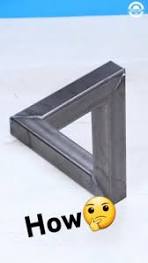Unlocking the Enigma of the Penrose Triangle: A Visual Marvel
The Penrose Triangle: A Fascinating Optical Illusion
The Penrose Triangle, also known as the impossible triangle or the tri-bar, is an intriguing optical illusion that challenges our perception of space and geometry. Designed by the mathematician Sir Roger Penrose and his father Lionel Penrose in the 1950s, this impossible figure appears to be a three-dimensional object that cannot exist in reality.
At first glance, the Penrose Triangle looks like a solid object with three straight beams connected at right angles. However, upon closer inspection, it becomes apparent that the structure is physically impossible to construct in three dimensions. The brain struggles to make sense of this paradoxical shape, leading to a sense of confusion and wonder.
What makes the Penrose Triangle so compelling is its ability to deceive our visual perception. By cleverly manipulating perspective and angles, the illusion creates the illusion of depth and solidity where none actually exists. This visual trickery challenges our understanding of spatial relationships and prompts us to question what is real and what is illusory.
Over the years, artists, designers, and mathematicians have been inspired by the Penrose Triangle and have incorporated its mesmerising geometry into various works of art, architecture, and graphic design. Its timeless appeal lies in its ability to captivate audiences with its seemingly impossible form.
Whether you see it as a mind-bending puzzle or a work of artistry, the Penrose Triangle continues to fascinate people around the world with its enigmatic beauty and mathematical elegance. It serves as a reminder that reality is not always as straightforward as it seems and that sometimes, what appears impossible may just be a matter of perspective.
Exploring the Enigma: 9 Fascinating Insights into the Penrose Triangle
- The Penrose triangle is an optical illusion that appears to be a three-dimensional object, but is actually impossible to construct in reality.
- It was first created by the Swedish artist Oscar Reutersvärd in 1934.
- The Penrose triangle is also known as the ‘impossible triangle’ or ‘impossible tribar’.
- When viewed from a certain angle, the Penrose triangle creates an illusion of depth and perspective.
- The Penrose triangle has been used in art, architecture, and design to create intriguing visual effects.
- It is often associated with concepts of impossibility and paradoxes.
- The Penrose triangle can be seen as a symbol of creativity, innovation, and thinking outside the box.
- Attempting to physically construct a Penrose triangle would result in an object that does not align properly in three dimensions.
- Studying the Penrose triangle can provide insights into perception, geometry, and visual cognition.
The Penrose triangle is an optical illusion that appears to be a three-dimensional object, but is actually impossible to construct in reality.
The Penrose triangle, a captivating optical illusion, presents itself as a seemingly tangible three-dimensional structure, yet in truth, defies physical construction in reality. This intriguing paradox challenges our perception of space and geometry, inviting us to ponder the boundaries of possibility within the realm of visual illusions.
It was first created by the Swedish artist Oscar Reutersvärd in 1934.
The Penrose Triangle, a mesmerising optical illusion that challenges the limits of perception, was originally conceived by the Swedish artist Oscar Reutersvärd in 1934. His innovative design laid the foundation for the creation of this impossible figure, which continues to captivate audiences with its paradoxical geometry and visual intrigue. Through Reutersvärd’s pioneering work, the Penrose Triangle has become a symbol of artistic ingenuity and a testament to the power of illusion in shaping our understanding of space and form.
The Penrose triangle is also known as the ‘impossible triangle’ or ‘impossible tribar’.
The Penrose triangle, alternatively referred to as the ‘impossible triangle’ or ‘impossible tribar’, is a captivating optical illusion that challenges conventional notions of geometry and spatial perception. Its aliases aptly capture the essence of this perplexing shape, which appears to defy the laws of physics by presenting a structure that cannot physically exist in three-dimensional space. The monikers ‘impossible triangle’ and ‘impossible tribar’ underscore the inherent contradiction embedded within this enigmatic figure, inviting viewers to ponder the limits of visual cognition and the boundaries between reality and illusion.
When viewed from a certain angle, the Penrose triangle creates an illusion of depth and perspective.
When viewed from a specific angle, the Penrose triangle cleverly manipulates perception to create an illusion of depth and perspective. This optical trickery plays with our sense of spatial awareness, making the impossible shape appear as a tangible, three-dimensional object. The magic of the Penrose triangle lies in its ability to challenge our understanding of reality by presenting a visual paradox that defies traditional notions of geometry and form.
The Penrose triangle has been used in art, architecture, and design to create intriguing visual effects.
The Penrose triangle has been a versatile and captivating element in the realms of art, architecture, and design, known for its ability to generate mesmerising visual effects. Artists and designers have drawn inspiration from this impossible figure to create optical illusions that challenge viewers’ perceptions and spark curiosity. In architecture, the Penrose triangle has been employed to craft innovative building facades that play with depth and perspective. Its presence in various creative fields showcases its enduring appeal as a symbol of creativity and ingenuity.
It is often associated with concepts of impossibility and paradoxes.
The Penrose Triangle is frequently linked to ideas of impossibility and paradoxes due to its perplexing nature. This optical illusion challenges our understanding of geometry and spatial relationships, creating a sense of wonder and confusion. The very concept of a three-dimensional object that defies conventional rules of construction evokes a feeling of impossibility, inviting viewers to question the limits of their perception. As a symbol of paradoxes and impossibilities, the Penrose Triangle continues to intrigue and captivate those who encounter its mesmerising form.
The Penrose triangle can be seen as a symbol of creativity, innovation, and thinking outside the box.
The Penrose triangle serves as a powerful symbol of creativity, innovation, and thinking outside the box. This optical illusion challenges conventional notions of geometry and pushes the boundaries of visual perception. By defying traditional rules of space and form, the Penrose triangle encourages individuals to explore new perspectives, embrace unconventional ideas, and unleash their imagination. It embodies the spirit of creativity and innovation, inspiring us to break free from limitations and see the world through a fresh lens.
Attempting to physically construct a Penrose triangle would result in an object that does not align properly in three dimensions.
Attempting to physically construct a Penrose triangle would lead to an object that defies the laws of geometry and spatial alignment in three dimensions. The inherent paradox of the Penrose triangle lies in its deceptive appearance of solidity and structure, which cannot be replicated in physical form. This impossibility highlights the power of optical illusions to challenge our perception and understanding of the world around us, showcasing the fascinating interplay between art, mathematics, and visual cognition.
Studying the Penrose triangle can provide insights into perception, geometry, and visual cognition.
Studying the Penrose triangle can provide valuable insights into perception, geometry, and visual cognition. By analysing this intriguing optical illusion, researchers and enthusiasts alike can gain a deeper understanding of how our brains interpret spatial relationships and process visual information. The complex interplay of angles and perspective in the Penrose triangle challenges traditional notions of geometry and invites us to explore the limits of our perceptual abilities. Delving into the mysteries of this impossible figure can offer a fascinating glimpse into the inner workings of our minds as we grapple with the boundaries between reality and illusion.


